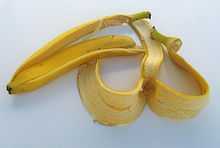Banana peel
.jpg)

A banana peel, known as a banana skin in British English, is the outer covering of the banana fruit.
Bananas are a popular fruit consumed worldwide with a yearly production of over 145 million tonnes in 2011. Once the peel is removed, the fruit can be eaten raw or cooked and the peel is generally discarded. Because of this removal of the banana peel, there is a significant amount of organic waste being generated.[1][2]
Banana peels are used as feedstock as they have some nutritional value. Banana peels are widely used for that purpose on small farms in regions where bananas are grown. There are some concerns over the impact of tannins contained in the peels on animals that consume them.[3][4] Banana peels are used as feedstock for cattle, goats, pigs, poultry, rabbits, fish and several other species.[5]
The specific nutrition contained in peel depends on the stage of maturity and the cultivar; for example plantain peels contain less fibre than dessert banana peels, and lignin content increases with ripening (from 7 to 15% dry matter). On average, banana peels contain 6-9% dry matter of protein and 20-30% fibre (measured as NDF). Green plantain peels contain 40% starch that is transformed into sugars after ripening. Green banana peels contain much less starch (about 15%) when green while ripe banana peels contain up to 30% free sugars.[3]
Banana peels are also used for water purification,[6] to produce ethanol,[7] cellulase,[8] laccase[9] and in composting.[10]
Banana peel is also part of the classic physical comedy slapstick visual gag, the "slipping on a banana peel".[11][12] This gag was already seen as classic in 1920s America.[13] It can be traced to the late 19th century, when banana peel waste was considered a public hazard in a number of American towns.[14][15] Although banana peel-slipping jokes date to at least 1854, they became much more popular, beginning in the late-1860s, when the large-scale importation of bananas made them more readily available.[16] Before banana peel jokes came into vogue, orange peels, and sometimes peach skins, or fruit peels/peelings/or skins, generally, were funny, as well as dangerous.[17]
The coefficient of friction of banana peel on a linoleum surface was measured at just 0.07, about half that of lubricated metal on metal. Researchers attribute this to the crushing of the natural polysaccharide follicular gel, releasing a homogenous sol.[18] This unsurprising finding was awarded the 2014 Ig Nobel Prize for physics.[19]
See also
- Bananadine, a fictional psychoactive substance in banana peels
References
- ↑ Derived from: "FAOSTAT". Food and Agriculture Organization of the United Nations. The data for bananas and plantains for 2011 were combined as the two are distinguished by some countries but combined under "bananas" by others.
- ↑ G.M. Babatunde: Availability of banana and plantain products for animal feeding. In: D. Machin, S. Nyvold: Roots, tubers, plantains and bananas in animal feeding. Proceedings of the FAO Expert Consultation held in CIAT, Cali, Colombia FAO ANIMAL PRODUCTION AND HEALTH PAPER 95, FAO, Rome, 1992.
- ↑ 3.0 3.1 Happi Emaga, T. ; Bindelle, J. ; Agneesens, R. ; Buldgen, A. ; Wathelet, B. ; Paquot, M., 2011. Ripening influences banana and plantain peels composition and energy content. Trop. Anim. Health Prod., 43 (1): 171-177
- ↑ Onwuka, C. F. I. ; Adetiloye, P. O. ; Afolami, C. A., 1997. Use of household wastes and crop residues in small ruminant feeding in Nigeria. Small Rumin. Res., 24: 233-237
- ↑ Banana peel entry on feedpedia.org
- ↑ A. Chaparadza, JM Hossenlopp: adsorption kinetics, isotherms and thermodynamics of atrazine removal using a banana peel based sorbent. Water Science Technology 65 (5), 2012, pp. 940-947
- ↑ HS Oberoi, PV Vadlani, L. Saida, S. Bansal, JD Hughes: ethanol production from banana peels using Statistically optimized simultaneous saccharification and fermentation process. Waste Management 31 (7), 2011, pp. 1576-1584
- ↑ Hai-Yan Sun, Li Juanhua, Pingjuan Zhao, Ming Peng: Banana peel. A novel substrates for cellulase production under solid-state fermentation African Journal of Biotechnology 10 (77), 2011, pp. 1788
- ↑ V. Vivekanand, P. Dwivedi, N. Pareek, RP Singh: Banana peel: a potential substrates for laccase production by Aspergillus fumigatus VkJ2.4.5 in solid-state fermentation. Applied Biochemistry and Biotechnology 165 (1), 2011, pp. 204-20
- ↑ F. Kalemelawa, E. Nishihara, T. Endo, Z. Ahmad, R. Yeasmin, MM Tenywa, S. Yamamoto: An evaluation of aerobic and anaerobic composting of banana peels treated with different inoculum for soil nutrient replenishment. , Bioresource Technology 126, 2012 pp. 375-82
- ↑ John Rosenberg (11 February 2013). The Healthy Edit: Creative Techniques for Perfecting Your Movie. CRC Press. p. 143. ISBN 978-1-136-04073-3. Retrieved 28 June 2013.
- ↑ Alan S. Dale (2000). Comedy Is a Man in Trouble: Slapstick in American Movies. U of Minnesota Press. ISBN 978-0-8166-3658-7. Retrieved 28 June 2013.
- ↑ Michael Dahl (1 March 2002). The Everything Kids' Joke Book: Side-Splitting, Rib-Tickling Fun. Adams Media. p. 99. ISBN 978-1-4405-2240-6. Retrieved 28 June 2013.
- ↑ "How Did Slipping on a Banana Peel Become a Comedy Staple?". Mental Floss. 2012-07-09. Retrieved 2013-06-28.
- ↑ "Banana Peel Last Night’s Garbage". Lastnightsgarbage.com. 2007-10-22. Retrieved 2013-06-28.
- ↑ Brown, Peter Jensen. "A Slippery History of the Banana Peel Gag". Early Sports 'n Pop Culture History Blog. Retrieved 5 January 2015.
- ↑ Brown, Peter Jensen. "A Slippery History of the Banana Peel Gag". Early Sports 'n Pop Culture History Blog. Retrieved 5 January 2015.
- ↑ Kiyoshi Mabuchi, Kensei Tanaka, Daichi Uchijima, Rina Sakai (2012). "Frictional coefficient under banana skin". Tribology Online 7 (3): 147–151. doi:10.2474/trol.7.147.
- ↑ "The 2014 Ig Nobel Prize Winners".